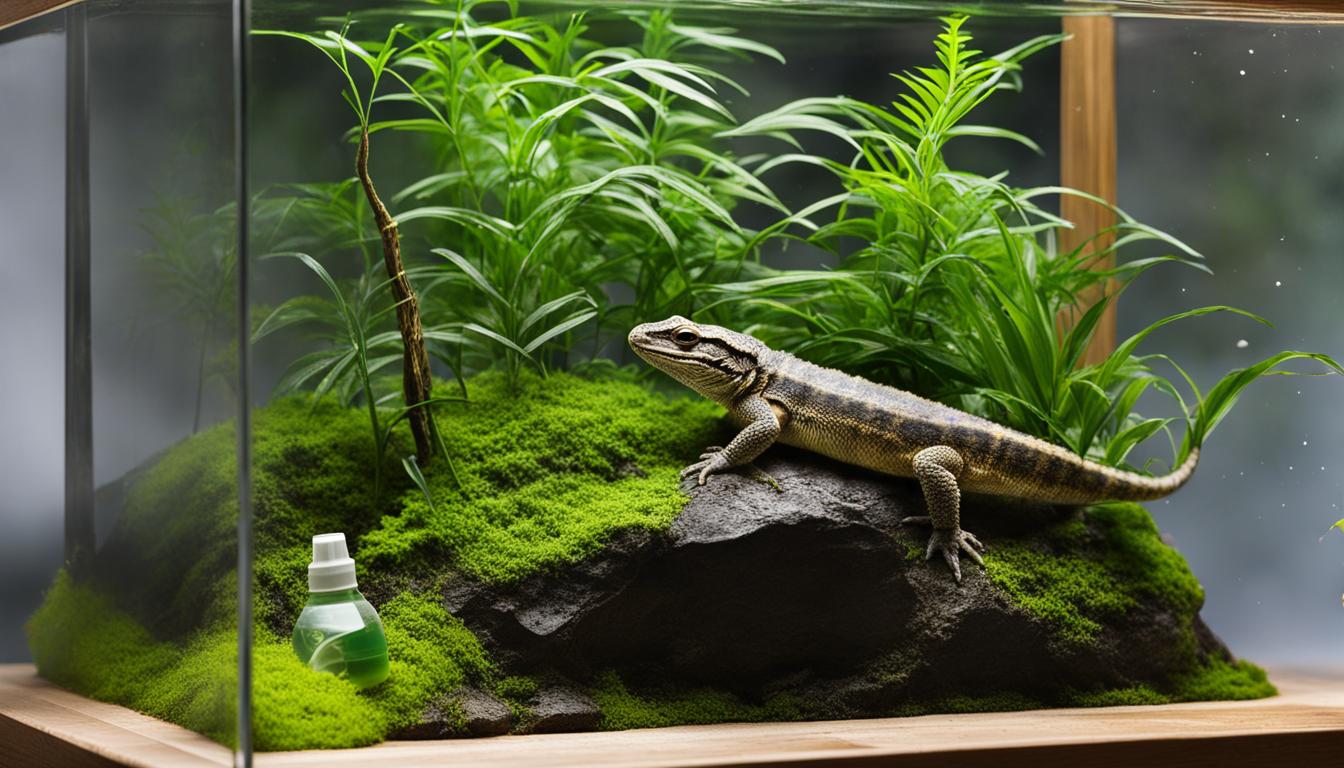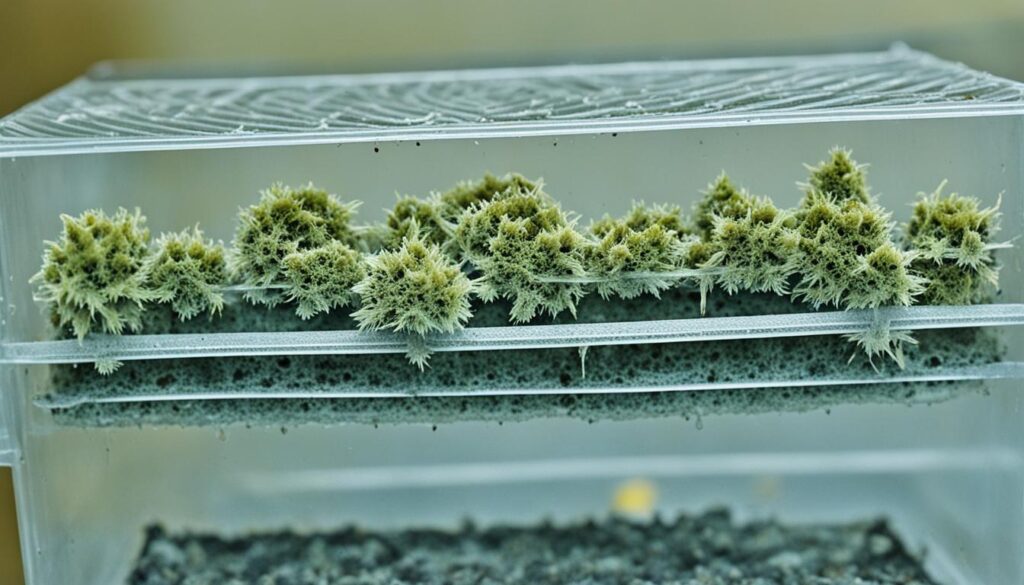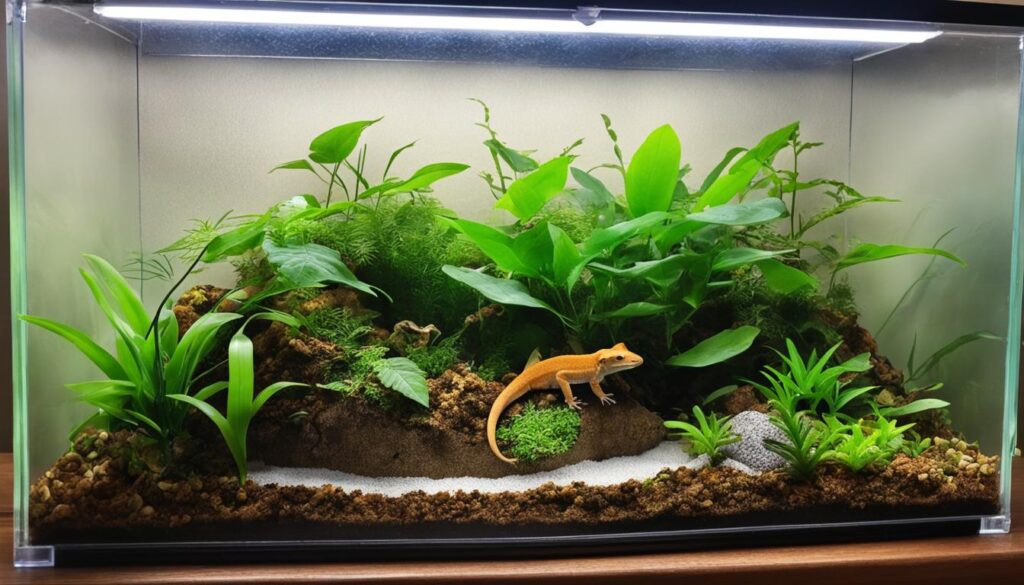
Mold Prevention in Crestie Cage: Effective Solutions
Welcome to our guide on mold prevention in crestie cages. As a reptile owner, it’s important to create a safe and healthy environment for your crestie. Mold issues in reptile terrariums can not only be unsightly but also pose potential risks to your pet’s health. In this article, we will explore effective solutions for mold removal in reptile terrariums, as well as provide tips and strategies for mold control in pet habitats.
Dealing with mold in a crestie cage can be challenging, but with the right knowledge and preventative measures, you can keep your pet safe and healthy. Understanding the dangers of mold and implementing proper maintenance practices are crucial for the well-being of your crestie. Additionally, maintaining proper humidity levels and choosing the right substrate and enclosure materials play a key role in preventing mold growth.
Proper ventilation and airflow in crestie cages are essential to prevent mold. Regular cleaning and maintenance practices are also important in removing any potential sources of mold in the cage. By following our recommendations and guidelines, you can create a mold-free and comfortable habitat for your crestie.
Throughout this article, we will provide detailed information on each of these topics, offering practical advice and expert tips. Let’s dive in and learn how to effectively prevent and tackle mold issues in crestie cages!
Key Takeaways:
- Implementing effective mold prevention measures is crucial for a healthy crestie cage.
- Understanding the dangers of mold and its impact on your crestie’s health is essential.
- Maintain proper humidity levels and choose suitable substrate and enclosure materials to prevent mold growth.
- Ensure adequate ventilation and airflow in the crestie cage to minimize the risk of mold.
- Regular cleaning and maintenance practices are necessary to keep the crestie cage mold-free.
Understanding Mold and Its Dangers in Crestie Cages
Mold can be a common issue in crestie cages and can pose potential dangers to the health of your pet reptile. Understanding the causes of mold growth and taking preventative measures is essential for maintaining a clean and safe environment for your crestie.
Dealing with mold in a crestie cage
Mold can thrive in damp and humid environments, making reptile terrariums an ideal breeding ground. Crestie cages are particularly susceptible due to the high humidity levels required for your gecko’s health and well-being. However, proactive measures can help prevent mold growth and protect your pet from any associated dangers.
Preventing mold in gecko enclosure
To prevent mold growth in your crestie cage, it is important to address the following:
- Proper ventilation and airflow: Ensure that there is adequate airflow within the cage to minimize moisture buildup.
- Substrate selection: Choose a substrate that promotes proper drainage and moisture control.
- Regular cleaning and maintenance: Clean the cage regularly to remove any potential mold spores.
- Humidity control: Maintain a consistent humidity level within the recommended range for cresties, as excessive moisture can lead to mold growth.
Mold remedies for crestie terrariums
If mold does appear in your crestie cage, it is essential to address it promptly to prevent further spread and potential harm to your gecko. Here are some steps you can take:
- Isolate the affected area: Remove any items or materials that show signs of mold growth and separate them from the rest of the enclosure.
- Clean and disinfect: Thoroughly clean the cage, including all surfaces, decorations, and substrate, using a reptile-safe disinfectant.
- Implement preventative measures: After removing the mold, take steps to prevent its regrowth, such as improving ventilation and reducing humidity levels.
In conclusion, understanding mold and its dangers in crestie cages is essential for every reptile owner. By taking proactive measures to prevent mold growth and promptly addressing any signs of mold, you can create a healthier and safer habitat for your crestie.

Maintaining Proper Humidity Levels in Crestie Cages
Proper humidity levels are vital for the health and well-being of your crested gecko, as well as preventing mold growth in their cage. In this section, we will explore the role of humidity in mold development and provide you with practical guidelines on how to maintain ideal humidity levels within your crestie cage.
The Role of Humidity in Mold Growth
Humidity plays a significant role in mold growth, and crestie cages are no exception. When humidity levels are too high, it creates a damp environment that encourages mold spores to thrive and multiply. Mold can pose a risk to both your crestie’s health and the structural integrity of their enclosure.
However, it’s important to note that maintaining some level of humidity is crucial for the well-being of your crested gecko. Cresties are native to tropical regions and require moderate humidity to support their respiratory health and proper shedding process.
Guidelines for Maintaining Proper Humidity Levels
So, how can you strike the right balance when it comes to humidity in your crestie cage? Here are some guidelines to help you maintain proper humidity levels:
- Monitor humidity levels: Use a digital hygrometer to regularly measure the humidity inside the cage. The ideal range for cresties is generally between 50% and 70% humidity.
- Provide a humidity gradient: Create different humidity zones within the cage to allow your crested gecko to regulate their exposure. This can be achieved by using a combination of misting, providing hiding spots with damp moss, and using a reptile-specific humidifier if necessary.
- Mist the enclosure: Misting the cage once or twice a day helps increase humidity and create a humid microclimate for your crestie. However, be cautious not to oversaturate the substrate or leave the enclosure too wet, as this can lead to mold growth.
- Use proper ventilation: Ensure proper airflow within the cage by incorporating ventilation holes or mesh screens. This helps prevent excessive moisture buildup and aids in maintaining an optimal humidity level.
Cleaning Tips for Moldy Reptile Tanks
If you notice any signs of mold growth in your crestie cage, it’s crucial to address the issue promptly to protect your pet’s health. Here are some cleaning tips to effectively remove mold from reptile tanks:
- Isolate the infected area: Once you detect mold, isolate the affected area by removing any contaminated objects or substrate from the cage.
- Prepare a cleaning solution: Mix a mild reptile-safe disinfectant with warm water. Follow the manufacturer’s instructions for proper dilution.
- Clean the enclosure: Use the cleaning solution and a non-abrasive sponge or cloth to scrub the moldy surfaces in the cage. Pay special attention to corners, crevices, and any areas where moisture tends to accumulate.
- Rinse thoroughly: Rinse all surfaces with clean water to ensure the removal of any residual cleaning solution.
- Thoroughly dry the enclosure: Before reintroducing your crested gecko, make sure the cage is completely dry to prevent mold from returning. Use a clean towel or allow the enclosure to air dry.
Following these guidelines for maintaining proper humidity levels and cleaning moldy reptile tanks will help keep your crestie’s environment healthy and mold-free. Remember, regular monitoring, appropriate ventilation, and prompt action are key to preventing mold growth in your crested gecko’s cage.
Choosing the Right Substrate and Enclosure Material
Mold growth in crestie cages can be minimized by selecting appropriate substrate and enclosure materials. It is crucial to choose options that discourage mold and create a healthy environment for your gecko. Let’s explore some effective choices for mold control and preventing mold in gecko enclosures.
The Impact of Substrate on Mold Control
The substrate plays a significant role in maintaining a mold-free habitat for your crestie. Opt for options that are moisture-resistant and have good airflow to prevent moisture buildup. Here are some ideal substrates:
- Coconut Fiber: Also known as coir, this natural substrate has excellent absorbency and promotes proper ventilation to prevent mold growth.
- Orchid Bark: Made from hardwood chips, orchid bark offers good drainage and aeration, reducing the chances of mold development.
- Paper Towels: A temporary option, paper towels are easy to replace and provide a clean environment. Ensure they are changed regularly to prevent mold accumulation.
Enclosure Material and Mold Prevention
The type of enclosure material you choose can also impact mold control in gecko enclosures. Consider the following options:
- Glass Terrariums: Glass enclosures are easy to clean and prevent mold growth when properly maintained. Ensure the top mesh screen allows for proper ventilation.
- PVC Cages: PVC enclosures are resistant to moisture, making them an excellent choice for preventing mold. They are also easy to clean and maintain.
- DIY Enclosures: If you prefer building your gecko enclosure, opt for materials like melamine or marine-grade plywood, which have lower moisture absorption rates and are less prone to mold.
Remember, regardless of the substrate and enclosure material you choose, regular cleaning and maintenance are essential for mold prevention. Conduct routine checks for any signs of mold and promptly address them to ensure a healthy habitat for your crestie.

| Substrate | Advantages |
|---|---|
| Coconut Fiber (Coir) | Excellent absorbency and ventilation |
| Orchid Bark | Good drainage and aeration |
| Paper Towels | Temporary, easy to replace |
| Enclosure Material | Advantages |
|---|---|
| Glass Terrariums | Easy to clean, proper ventilation |
| PVC Cages | Moisture resistant, easy maintenance |
| DIY Enclosures | Lower moisture absorption, customizable |
Proper Ventilation and Airflow in Crestie Cages
When it comes to preventing mold growth in your gecko enclosure, proper ventilation and airflow play a crucial role. Adequate airflow helps to maintain a healthy environment and reduces the likelihood of mold formation. In this section, we will explore the significance of ensuring proper ventilation in your crestie cage and provide recommendations to control mold effectively.
One of the key reasons mold thrives in reptile habitats is the presence of stagnant air. Insufficient airflow can lead to moisture buildup, creating an ideal environment for mold growth. By ensuring proper ventilation, you can promote air circulation, reducing moisture levels and preventing mold formation.
Here are some tips to ensure adequate ventilation and airflow in your crestie cage:
- Choose an enclosure with appropriate ventilation holes or mesh panels to allow fresh air to circulate.
- Avoid using airtight or enclosed habitats that restrict airflow.
- Position the cage in an area with good air circulation, away from damp or humid spaces.
- Consider using fans or installing ventilation systems to enhance air movement in the cage.
- Regularly clean the enclosure to remove any debris or substrate that may obstruct airflow.
Remember, maintaining proper ventilation and airflow is essential for preventing mold growth in your gecko enclosure. By following these recommendations, you can create a healthy and mold-free environment for your crestie.
Regular Cleaning and Maintenance Practices
Maintaining a clean and hygienic crestie cage is essential for preventing mold growth and ensuring the well-being of your pet. Regular cleaning and maintenance practices can go a long way in keeping your reptile’s habitat free from mold and other harmful substances. In this section, we will provide you with step-by-step instructions and valuable cleaning tips for moldy reptile tanks.
Step 1: Remove and Clean Decorations and Accessories
Start by removing all decorations, accessories, and substrate from the crestie cage. These items can accumulate moisture and provide a perfect breeding ground for mold. Use a mild dish soap or reptile-safe cleaning solution to scrub and clean each item thoroughly. Rinse them well with clean water and allow them to air dry completely before returning them to the cage.
Step 2: Empty and Clean the Cage
Empty the crestie cage completely, including any substrate or bedding material. Dispose of any moldy or contaminated substrate safely. Using warm water and a reptile-safe disinfectant, carefully clean the entire cage, including walls, floors, and any hard surfaces. Pay special attention to areas where moisture can accumulate, such as corners and crevices. Rinse the cage thoroughly and allow it to air dry before proceeding.
Step 3: Replace Substrate and Bedding
Replace the substrate and bedding material with fresh, clean options. Avoid materials that retain excessive moisture, as they can contribute to mold growth. Consider using paper towels, reptile carpet, or other dry and easy-to-clean substrates. Ensure that the bedding is spread evenly and not overly compacted to allow for proper airflow.
Step 4: Monitor and Control Humidity Levels
Maintaining proper humidity levels is crucial in mold prevention. Regularly monitor the humidity levels in the crestie cage using a hygrometer. Keep the humidity between 50-70%, as excessively high or low humidity can promote mold growth. Use a misting system or spray bottle to provide periodic moisture, ensuring that the cage does not become saturated.
Step 5: Regular Spot Cleaning
Perform regular spot cleaning to remove any waste or spilled food from the crestie cage. Spot cleaning should be done daily or as needed to maintain a clean and odor-free environment for your pet. Promptly remove any moist or soiled substrate and replace it with fresh bedding.
Step 6: Deep Clean and Disinfection
Perform a deep clean and disinfection of the crestie cage at least once a month. Follow the same procedure as step 2, ensuring that all surfaces are thoroughly cleaned and disinfected. This includes any hiding spots, branches, or other cage accessories. Allow the cage to air dry completely before reintroducing your crestie.
By following these regular cleaning and maintenance practices, you can significantly reduce the risk of mold growth in your crestie cage. Remember to monitor the cage regularly for any signs of mold or excessive humidity and address them promptly to maintain a healthy and safe environment for your beloved reptile companion.
Conclusion
In conclusion, proactive mold prevention in crestie cages is crucial for maintaining a healthy environment for your pet. Throughout this article, we have explored effective strategies and tips for mold removal and prevention in reptile terrariums. By implementing these measures, you can ensure the well-being of your crestie and create a safe habitat for them to thrive.
Understanding the dangers of mold in crestie cages is essential. Mold growth can lead to respiratory issues and other health problems for your pet. To prevent mold, it is important to maintain proper humidity levels, choose the right substrate and enclosure material, and ensure adequate ventilation and airflow.
Regular cleaning and maintenance practices are also key to mold prevention. Cleaning your crestie cage regularly and following proper cleaning techniques will help eliminate any potential mold growth and maintain a hygienic environment for your pet.
By following these guidelines and incorporating the tips provided in this article, you can create a mold-free and healthy habitat for your crestie. Remember, mold prevention is essential for promoting the well-being of your pet reptile and enhancing their overall quality of life.




